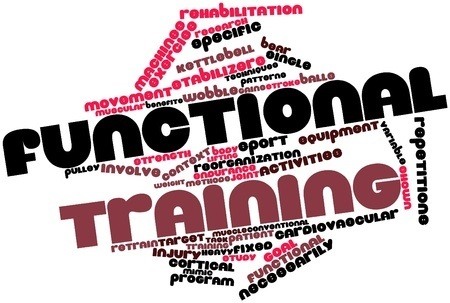
Today there are so many different opinions on how one should properly coach personal training clients. “What type of training should I be doing?” is the big question. “Do I perform slow or fast reps?” “Do I use a bench or a physio-ball?” “Do I do one body part at a time?” The answer is that everyone should be training in a manner that relates to his or her individual goals. So where and how does functional training fit into everyone’s goals?
The Flaw of One-Approach Training
There is no one set routine that equally benefits everyone who does it. Performing a typical bodybuilding program of random exercises, (three sets of ten, with one-minute rests, etc) certainly has benefits, but will not be the most efficient way to attain every goal or address specific needs.
Training primarily with machines and not using free weights is inefficient in the long run because you are moving resistance along a fixed axis, and not freely in space, as the body normally functions. Machines have limited functional strength transfer to real-life situations in most cases, and can actually create poor motor patterns in some people. Machines have value when integrated properly, but they are often misused or overused.
And constantly changing variables and approaches in unusual ways may stave off boredom, but it will rarely achieve any goals beyond achieving a greater level of fitness. Functional training is a way to incorporate different approaches and elements and tailor it for each client’s goals and needs.
What is Functional Training?
Functional training is defined as movements or exercises that improve a person’s ability to complete their daily activities or to achieve a specific goal. It is not a series of exercises deemed functional by some manual. Doing movements in the gym that strengthen the muscles involved in the movements you wish to improve outside the gym is a good start. This does not mean you can simply add weight to the exact movement you wish to enhance.
There is research that has proven adding weight to a target movement can actually be detrimental to some athletic movements. When a baseball player adds weight to his bat, it can actually slow his bat speed down because the added resistance changes the forces on the joint and disrupts mechanics.
All exercises have some functional value when applied correctly, this value is determined by the exercises’ transferable benefit outside the gym. Every exercise has a functional limitation and it is up to the trainer to understand what it is. A good program focuses on weak areas and sets specific goals for the client. It is important to understand how to progress someone from simple smaller targeted movements to more complex multi-joint movements.
Functional training can range from having a tennis player lunge-to-chop, or a bodybuilder perform negatives for bigger biceps; it’s all about the specific goal. Keep in mind doing complex movements before the client is ready will do more harm than good.
To build appropriate muscle strength, joint integrity, balance, and flexibility in all planes of motion, it is essential that the body is exercised with “function” in mind. Functional training includes multi-joint and multi-planar exercises, as this recruits the body’s stabilizers to synergistically facilitate movement, ensures that the nervous system is working properly, and that all parts of the body are used appropriately, with the correct muscles firing at the right time.
This is not to say you shouldn’t include some so-called non-functional exercises, including machine work, that are safe and fun when applied correctly. To create a comprehensive functional program, a trainer must set realistic goals and understand the client’s weaknesses, daily activities, and limitations.
A highly competent trainer, such as a functional training specialist, must be able to identify postural distortions and include exercises that correct them, but more importantly, they have to educate the client on what movements or activities to avoid or modify during their day. It’s not what you do; it’s how you do it.
The ability to identify a postural distortion is dependent on the trainer’s understanding of anatomy, motor patterns, and muscle function. A highly competent trainer can identify when muscles are overactive and firing out of sequence, or not firing at all.
Synergistic dominance is common in most postural dysfunctions. In general, if the agonist is tight then the antagonist is weak, thus creating increased stress on the joint. This can result in patterns of repetitive stress, ultimately leading to accelerated joint degeneration.
Core stability, flexibility/mobility, and balance are key factors when designing a functional exercise routine. It is important to maintain posture while being able to move all joints in a full range of motion. Training with free weights, and challenging the surrounding environment promotes balance and stability, which is necessary if you expect to see benefits outside of the gym. Keep in mind, it is more important to be able to control your own body weight and concentrate on form, balance, and core endurance, than to move heavy weights.
Functional Training for the Core
A functional training core routine consists of dynamic movements, isometric exercises and challenges the center of gravity. To completely train the core, you must also include dynamic stabilization, isometric and proprioceptive movements, not just for the midsection, but for the entire trunk. Medicine balls, balance boards, foam rollers and physioballs are great tools for core training, and should be integrated into every program. It is a fact that training on the physio-ball (challenged environment) is superior to traditional floor exercises.
As a person ages, balance and stability become compromised. If balance and stability are not addressed, they will consistently degrade. A weak core contributes to poor stability, and inhibits proper limb movements, causing muscle imbalances in the kinetic chain. This is why falls are common in the geriatric population.
Many back and hip injuries are related to weak core muscles. There are many small muscles in the core that the general population knows little about or addresses during exercise. In most spinal injuries, MRI mages show atrophy in these small muscles. In order to maintain a healthy spine, these little muscles need to be trained.Without stability, even the strongest person can not effectively propel a force into the environment.
Mobility is a very important facet of any exercise program, but is often overlooked. Lack of mobiltiy appears to be the root of many problems. The body’s movements are hampered when flexibility and posture are distorted. Active, dynamic, static, and PNF stretching are key factors and should all be included in any training program.
When a muscle is overactive and short, it limits the muscle’s ability to contract properly, causing inefficient movements and risk of injury. Without flexibility, the body’s movement becomes limited, and good results are difficult to achieve.
This article has explained the key components of a functional program and its benefits. The best way to enhance movement is to mimic the real-life movement in the gym until it becomes autonomous in everyday life. Before initiating any exercise program, one should always consult a physician, as well as a qualified fitness professional. This insures that they are addressing their specific needs and goals.
References
1. Cosio-Lima LM, Reynolds KL, Winter C, Paolone V, Jones MT. Effects of physioball and conventional floor exercises on early phase adaptations in back and abdominal core stability and balance in women. J Strength Cond. Res.2003 Nov;17(4):721-5
2. Hides, J. A., Richardson, C. A., and Jull, G. A. Magnetic resonance imaging and ultrasonography of the lumbar multifidus muscle. Comparison of two different modalities. Spine 20:54-8; 1995
3. Hides, J. A., Stokes, M. J., Saide, M., Jull, G. A., and Cooper, D. H. Evidence of lumbar multifidus muscle wasting ipsilateral to symptoms in patients with acute/subacute low back pain. Spine 19:165-72; 1994
4. Kiyoshi Yoshihara, MD; Yasumasa Shirai, MD; Yoshihito Nakayama, MD; Shinji Uesaka, MD. Histochemical Changes in the Multifidus Muscle in Patients With Lumbar Intervertebral Disc Herniation. Spine 2001;26:622-626
5. Julie A. Hides, PhD; Carolyn A. Richardson, PhD; Gwendolen A. Jull, MPhty Multifidus Muscle Recovery Is Not Automatic After Resolution of Acute, First-Episode Low Back Pain. Spine 1996;21:2763- 2769
6. Etty Griffin LY. Neuromuscular training and injury prevention in sports. Clin Orthop.2003 Apr;(409):53-60






